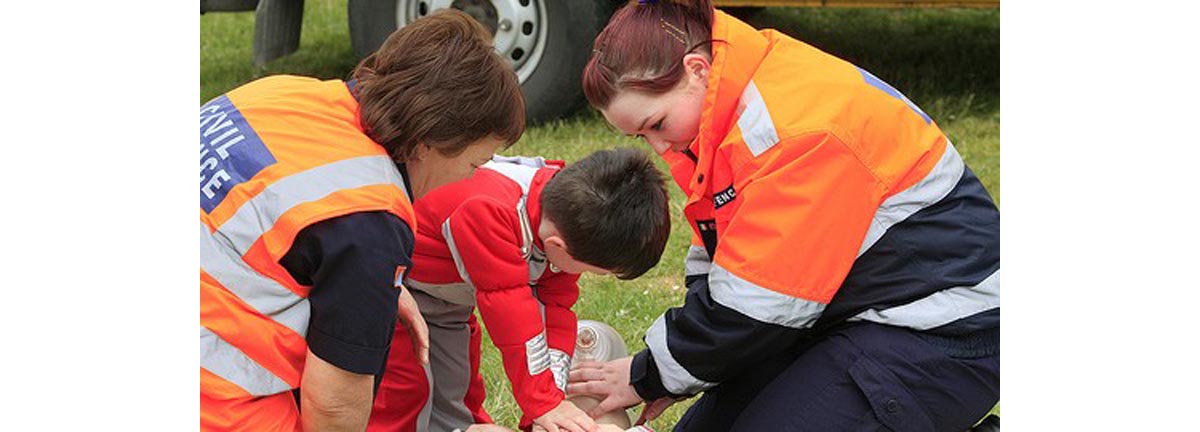Table of Contents
You can watch videos (links are below), take classes, or listen to instructions from a 911 (emergency) operator, but you can learn the basics of the new CPR right now, in just a few minutes.

Suppose you see someone fall down in front of you, no longer breathing.
Here is what you need to do.
- First, determine whether the victim is in a faint, or in a cardiac arrest. This is something you have to know very quickly. Kick them on the feet, shake their shoulders, and see if they can be roused. If they don't respond, and they aren't breathing, ask someone near you to call 911 (or the emergency number in your country), and if you are the only person with them, you call 911.
- Next, start CPR. Make sure the person you are helping is lying flat on their back on the floor. Then kneel down and lean over them, placing your right hand directly over their sternum, the breastbone. You don't have find any exact spot on the chest, but keep your hand in the middle of the chest as much as possible. Then weave the fingers of your left hand between the fingers of your right hand and start pressing at 100 times per minute. If you know the song Stayin' Alive, just do compressions to the beat. If you don't know Stayin' Alive, then give CPR to the beat of Row, Row Your Boat.
- Don't worry about cracking ribs. If you don't give CPR, the person is already dead. It isn't easy to cause injury in most people, but taking a CPR class with practice dummies will give you a feel for the right pressure to use in emergency situations.
That's all you have to do, but you have to keep doing it until help comes. It's hard work, but you have to keep it up until help comes, or until they start breathing on their own. Don't try to talk to an emergency response or rescue operator on the phone and give CPR at the same time. Just give them the address, explain what is happening, and get to work.
When CPR works, the victim starts breathing agonally, with a gasp. It is extremely unpleasant to breathe this way, and the victim may want to give up. If breathing resumes, try to talk to the victim to encourage them to stay awake (encouraging circulation to the brain) and to keep breathing. If breathing stops, start CPR again.
Give CPR before you use an automatic electronic defibrillator (AED). Often the pulse simply is undetectable. The automatic defibrillator won't give a shock unless it is needed, but oxygen in the bloodstream is essential before the heart is restarted.
Once you start CPR, don't quit. In most cases outside of the hospital, CPR only preserves life long enough for treatment with the automatic electronic defibrillator brought by the emergency response team, which brings heart rhythm and breathing back to normal.
Medical studies have shown that deaths occur when first responders switch with partners. Find the strength to keep on giving cardiopulmonary resuscitation in the knowledge that there is about a 50% chance that not only will the person you are giving aid live, but live with their mental faculties, their personality, and their memories intact. By giving the victim of sudden death the new CPR, you are giving them their only chance at survival, and you are giving them a 3500% better chance of survival than they could receive from the old method.
- Herlitz J, Svensson L, Holmberg S, Angquist K, Young M. Efficacy of bystander CPR: Intervention by lay people and by health care professionals. Resuscitation. 2005. 66:291–295. doi: 10.1016/j.resuscitation.2005.04.003.
- Trowbridge C, Parekh JN, Ricard MD, Potts J, Patrickson WC, Cason CL. A randomized cross-over study of the quality of cardiopulmonary resuscitation among females performing 30:2 and hands-only cardiopulmonary resuscitation. BMC Nurs. 2009 Jul 7. 8:6. doi: 10.1186/1472-6955-8-6.
- Photo courtesy of ozarksredcross on Flickr: www.flickr.com/photos/ozarksredcross/4352081361
- Photo courtesy of leppre on Flickr: www.flickr.com/photos/leppre/2502570443


Your thoughts on this